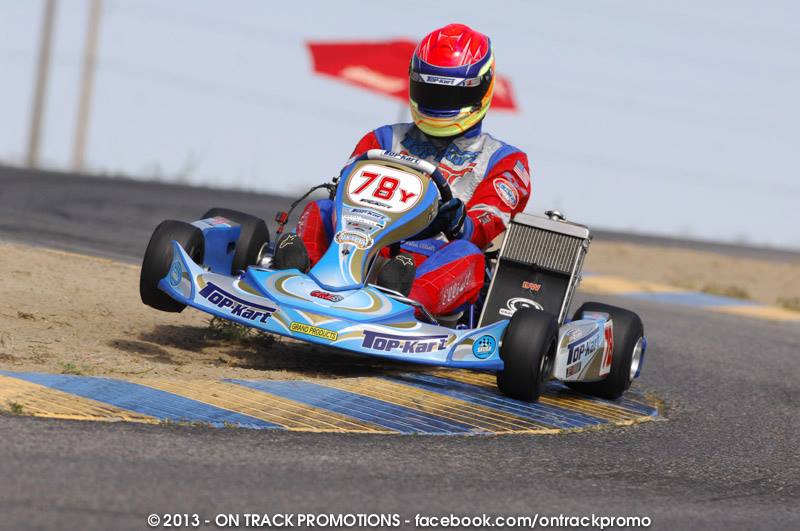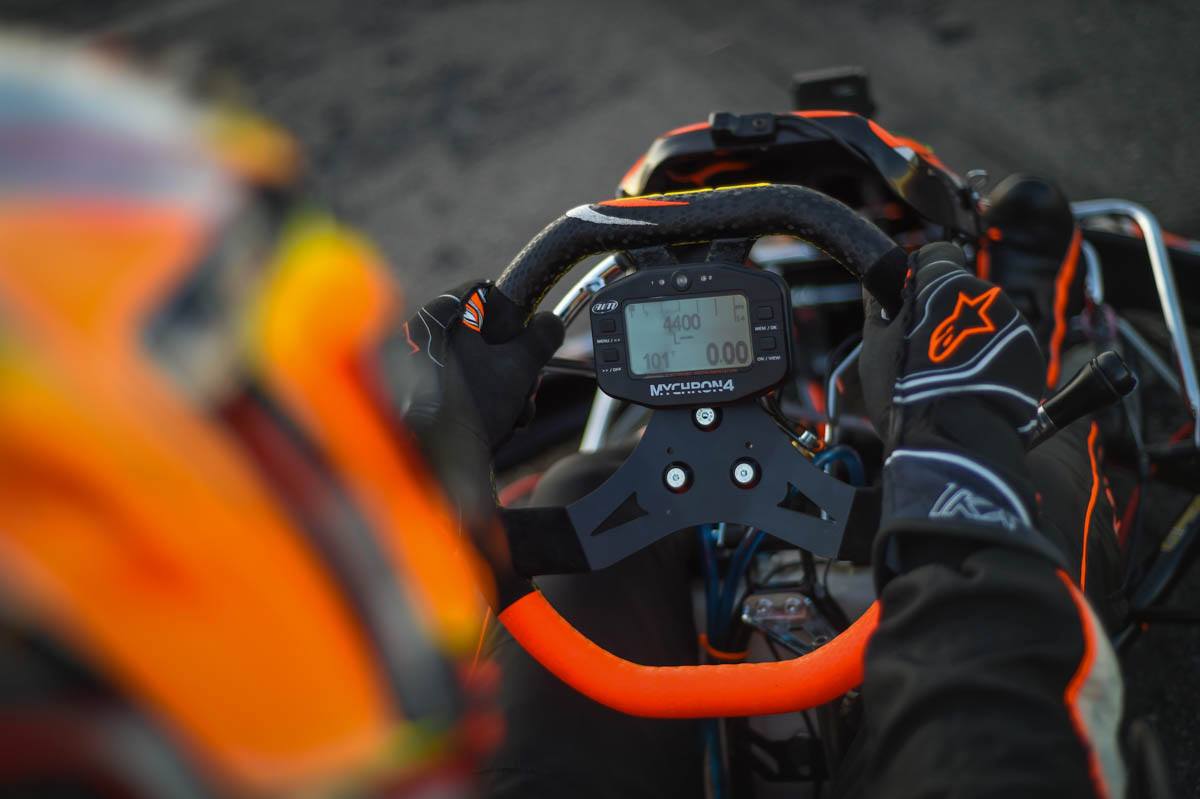Here’s part 2 of a series of articles I’m writing about driver feedback. In this piece, I attempted to tackle the subject of how to develop your ability to sense a kart’s basic handling characteristics.
Feedback: Driving Feel
As I wrote the first article in this series, I realized that discussing the topic of feedback in detail has the potential to put the ‘kart before the (proverbial) horse’ if certain assumptions are not first addressed. If you are invited to go on a hike with friends, it is assumed that you already know how to walk. If you are asked to give a keynote speech, it is assumed that you already know how to write, read, and speak a language. Therefore, if feedback is expected from a driver, it is assumed that they already know how to sense a kart’s handling issues.
Equating the learning of driving ‘feel’ to learning to walk or a language is not as far-fetched as many would think—any driver that has experienced racing in adverse conditions such as rain or on dirt for the first time can attest to this. With this in mind, the following tips on developing driving ‘feel’ should not be viewed as only applicable to the complete newbie.
By developing your ability to sense a kart’s behavior as you drive it, so too will you develop your ability to add new dimensions to your feedback. Where before you may have described the kart as just ‘loose’ or ‘tight,’ after intentional practice you will begin to describe exactly where this is occurring, a new level of detail that top drivers work to achieve.
Buying into the Hype: Believing in Chassis Dynamics
The most important step in beginning to develop enhanced feel for a kart is to understand, internalize, and believe that a kart must flex, bend, and warp in order to perform at its best. For many new drivers, simply understanding that this behavior is normal and vital for a kart to perform at its best allows them to become more comfortable with their driving.
If you are still unfamiliar with the sensation of chassis flex, a great exercise to do before beginning driving each day is to find an area of the paddock that looks mostly uniform, but with some small bumps. Have someone push you in a straight line through this area; The kart should come alive, warping and twisting subtly over even the slightest bumps in the pavement, causing your torso, legs, and arms to move independently from each other slightly as the chassis bends in reaction to the driven surface. With this simple exercise, an appreciation and sense for the most fundamental ability of a kart can be reached—it’s propensity to flex and to react to the track with remarkable speed and ability.
Now that you have an understanding and basic sense for your kart’s flexibility, we have the opportunity to explore how to sense two of the most basic chassis behaviors in motorsports: Under steer and over steer.
Sensing Basic Handling Behaviors
Developing an advanced feel or skillset in any activity requires intentional practice. For example, if you decided you wanted to learn to fly a plane, it is almost assured that within your first few hours of training, the instructor would compel you to force the plane into a stall. The instructor does not do this because they want you to stall the plane every flight; new pilots are forced to experience stalls because it forces them to develop a sense for their surroundings. Just like flying, driving a kart well requires the development of a sense for the handling of the vehicle. For most drivers, the development of this sense will most rapidly begin to develop when they are placed in moderate to extreme handling conditions.
Especially as a new driver, having a feel for a kart’s handling at its extremes early on in the learning process is extremely beneficial. I say this because it takes extreme occurrences, such a spin or a small off-track experience, to cement in a driver’s mind that a line was truly crossed in driving, in the form of extreme over steer, or extreme under steer. With this in mind, a great place to start when learning to enhance driving feel is working with your kart near the realm of one of these conditions. Now, to be clear, I don’t advise endangering yourself or others by adjusting chassis settings to make your kart impossible to control. However, a severe under steer condition is going to be a lot easier to get a feel for initially as opposed to a subtle one.
If you want to gain a better sense of your kart’s handling, a great place to begin to do this is at a controlled practice day. Once at the track, take careful stock of your kart’s chassis settings. Following this, make a substantial change to one of these settings, again making notes along the way. For most drivers, erring on the side of experiencing severe under steer is a safer bet than extreme over steer at first. If you’re unsure of what to adjust at first, don’t worry. Most chassis have great basic factory tuning guides, and of course other racers can give you some advice. Whatever you change, always make sure to document!
For your first few days at the track working on developing your feedback, I’d recommend to simply sticking to the basic under steer and over steer. At first, these two conditions will form the basic ingredients for most handling issues a kart will develop. The more experience you gain with these two conditions, the easier you will be able to sense them coming on, and the quicker you will be able to react to them in the future. Just like a pilot monitors his altitude, attitude of the plane, and heading, so too will you as a kart driver begin to feel within the kart when a corner is being taken too fast, or too slow. The ‘feel’ of the kart will begin to come to you.
Just like a MyChron, your mind can store data as you drive. Taking the time to practice logging handling information can give you an edge off the track. (PC: On-Track Promotions)
Processing and Storing Handling Behaviors
Before you head out onto the track after making chassis changes, think through what the kart may do. Is it likely to turn better in the corners, or worse? Will the front slide, or will the rear? If you’re unsure, consider asking more experienced drivers. By asking yourself these questions, you will begin to develop an automatic habit of constantly evaluating the kart’s behaviors in the corners, and store this feedback away in your brain. Depending on the chassis adjustments you have made, the kart is likely to change its behavior significantly from what you may be used to. Do your best to notice where the kart slides, and where it grips. Most importantly, make sure to work up to your top speed. After all, you could be approaching a realm of new handling characteristics yet unknown to you.
As you begin to inch ever closer to the edge of your driving abilities in a session, your responsibilities as a driver increase dramatically. The kart will become more and more responsive, giving you greater and greater feedback. At the limit, the information you will gather through your developed sense for handling of the kart will be invaluable to yourself off the track, as well as your mechanic, should you have one. Below, I have listed some good tips to get you started down the right path to being able to store detailed handling information as you drive:
• Have a plan prior to each session. Even the simple act of deciding how many laps to run and at what pace does wonders to engage your new-found hyper-sensitive-kart-handling brain.
• Work up to the limit of the kart. As mentioned before, often chassis changes can make the kart behave differently than you have experienced before.
• As you drive, make note of where the kart exhibits each behavior you experience. For example, if a kart over steers in the rear as soon as you turn into a corner, it is crucial to note this, rather than to recall it as sliding through the entire corner later. Top level drivers often will break down a corner into three segments—corner entry, middle, and exit.
• Pay attention to general trends in handling. Does a handling issue get worse as you continue to drive, or does it get better? Sometimes, this answer can be complicated due to external factors. Still, in an ideal case, a driver’s lap times will match the state of the kart’s handling, which can be another rough metric to keep track of.
• If you are following another driver with a similar kart, make note of where you appear to be stronger, and where they seem to pull away. How does their kart behave compared to yours?
Once you have complete each session, make a habit of taking a moment to visualize in your mind your best lap, and then contrast this with your slowest lap. What differences do you notice? Visualize a lap in your mind, and determine where the biggest areas of struggle are. For many drivers, this process can initially take several minutes, just sitting in the kart, contemplating. Once you are done with this de-compression time. If you’re up for it, take a moment to write down your impressions of the session in a notebook (we will cover recording de briefs in the next installment).
Conclusion
It is highly unlikely that using the ‘factory’ settings on your kart will yield the best result at every track all the time. Similarly, your ‘factory’ level of driving comfort is likely not going to be enough to get the best out of yourself and your kart at every race. Intentionally working to get out of your comfort zone is often the most straightforward way to truly experience handling maladies.
–Eric Gunderson

